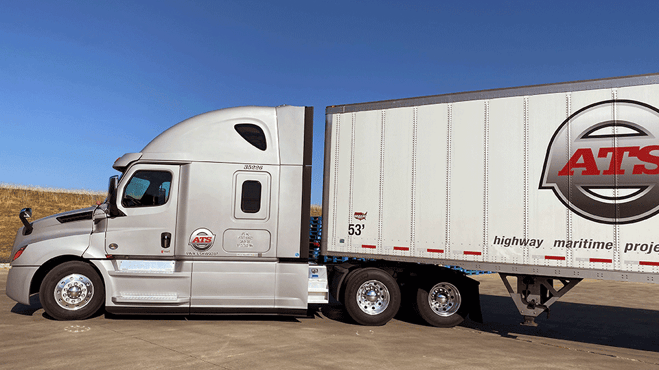
Strong winds, the enemy of many things: kites that are grounded by a thin rope and a child’s grip; urgent flights over the Rocky Mountains; those tube men that retail companies use as advertising tools and every well-set picnic table ever.
While a lost kite is discouraging, a canceled flight frustrates and nobody likes to watch their potato salad drift across the park, none of this touches the damaging toll high wind speeds can take on the transportation world.
As a shipper, with commitments to meet and items to distribute, the last thing you need is another thing to worry about. But, alas, heavy winds and the potential danger they bring to transportation processes can’t be ignored or avoided.
In the past, substantial wind speeds have made an impression on your bottom line, stalling your supply chain, production schedules and goal achievement. What makes matters worse is the unpredictability of these events. Seemingly without warning, a sudden outcropping of high wind can turn a fruitful, well-arranged transportation transaction, into a headache that reverberates days into the future.
Here at Anderson Trucking Service (ATS), our 65 years in the transportation business have taught us how to navigate many things including seasonal shifts, tight marketplaces and higher-than-average fuel prices. Unfortunately, however, when high wind speeds rear their heads, there is little transportation companies — and their customers — can do.
In this article, you’ll find an explanation as to what the transportation industry classifies as “heavy” wind, why these wind speeds make freight movement so dangerous and what you can do to avoid the impact of these events in the future.
At its conclusion, that feeling in the pit of your stomach each time Al Roker says “expect to see some high winds today, folks” won’t be so deep and your supply chain will be better off for it.
What Is Considered “Heavy” Wind?
The National Weather Service, a governmental agency tasked with overseeing the distribution of timely weather-specific information, separates high wind speeds into six categories, organized by threat level:
- None: Wind speeds are considered non-threatening and “light”. Typically, non-threatening winds are reported below 20 mph.
- Breezy: Wind speeds that hover at, or around, the 20 mph mark with occasional gusts up to 30 mph are considered to be “breezy” conditions. These pose a very low threat to the motoring public, property and individuals.
- Windy: Continuous wind speeds landing between 21 and 25 mph with frequent surges up to 35 mph are “windy” conditions. The National Weather Service classifies these conditions to be of low threat to motor vehicles and property.
- Very Windy: When sustained wind speeds exceed 25 mph, consistently falling between 26 and 39 mph with gusts up to 57 mph, these conditions are sufficient for a wind advisory and pose a moderate threat level.
- High Wind: Wind conditions that sustain speeds between 40 and 57 mph are considered by The National Weather Service to be of a high threat to people, motor vehicles and property.
- Damaging High Wind: At this point, continuous speeds of more than 58 mph are extremely dangerous for people, motor vehicles and property. Travel of all distances is highly discouraged.
To safely execute their duties, transportation companies carefully monitor and abide by all travel advisories administered by The National Weather Service. That said, most carriers pre-emptively limit the movement of their drivers as soon as sustained winds speeds of 30 mph — with gusts up to 45 mph — occur.
It’s at this point that what The National Weather Center classifies as “windy” conditions begin making an impact on the safety of freight transportation.
Why Are High Wind Speeds Dangerous For Transportation Companies?
As high-profile vehicles — vehicles with a raised center of gravity and greater-than-average total surface area — semi-trucks and their trailers (typically measuring 72 feet long and more than 13 feet high) are highly susceptible to the impact of wind.
Shifting cargo, repeat jostling and unexpected imbalance due to gusting winds can be dangerous for both the drivers behind each wheel and the motoring public surrounding them.
When wind speeds get strong enough — gusting into the 35 to 40 mph range — the likelihood for rollovers, freight damage, lost tarps (for open-deck shipments), motor vehicle accidents due to unexpected lane changes and trucks running off the road, all increase.
Although lighter loads are more susceptible to the effects of high winds, even the heaviest trailers can be blown off course by an extreme gust.
In the worst cases, incidents caused by extreme wind speeds can end in serious injury and the loss of life.
How Are Drivers Trained For High-Wind Safety?
With so much at stake for trucking companies, their drivers and the larger motoring public, it’s imperative that trucking companies properly train drivers for scenarios of heavy wind.
Although each carrier is different, here at Anderson Trucking Service, drivers under our employ, among other things, are taught to:
- Slow down and proceed with great caution once wind speeds hover between 35 and 40 mph — a range listed by The National Weather Service in the “moderate” threat level.
- Plan their route based on wind direction and projected areas of impact. Try to drive with the wind whenever possible and avoid locations that are slated for heavy wind conditions.
- Always pull over and park as soon as they don’t feel safe until wind speeds subside.
- Pay attention to all wind advisories, watches and warnings and plan accordingly.
More than anything else, great trucking companies understand that — where heavy winds are concerned — proper planning can truly save lives.
As such, these carriers communicate weather updates with each driver, help them plan the best avenue of attack, reroute them if necessary and ensure that wind speeds are safe before they point their wheels toward the open road.

What Can You Do About Transportation Mishaps Caused By High Wind Speeds?
When it comes to avoiding the impact of heavy winds on your transportation supply chain, there’s very little you can do. Safety should be your top priority in these situations. And, even though it can be inconvenient when a shipment needs to be rescheduled, should the situation call for it, sometimes, doing so is unavoidable.
The last thing you want to do is have a full truckload of products get severely damaged or destroyed by extreme wind conditions. The dollars lost in these scenarios far outweigh the cost of scheduling a shipment.
For this reason, the best thing you can do when heavy winds penetrate your plans is to pivot. Don’t fight national weather advisories. Understand the potential fallout from sending freight in these conditions. And, work with your transportation provider and consignees to plan loads around outcroppings of heavy wind.
Shippers and receivers that understand how dangerous these conditions can be and how challenging they are for drivers can avoid the potential fall out of ignoring them.
Prioritize Safety in Your Transportation Network
Safety is an important piece of every supply chain. The best transportation companies take safety seriously and work to mitigate mishaps at every turn — even when the weather makes doing so difficult.
As your journey with the transportation world continues and your shipping volumes continue to rise, you’ll want to make sure to fill your network with the safest providers around. That said, here at ATS we recognize that choosing a great provider can be difficult, especially with so many options out there.
To help you make these crucial decisions, decisions that will drive your company forward, download our 30 question freight carrier vetting guide today. This tool, designed to give you the upper hand and teach you what to look for in a great transportation provider, will help you ensure each carrier you select holds to top-of-the-line safety standards.
For more safety-related content, check out these additional pieces:
- How Does Winter Weather Impact The Trucking Industry?
- 5 Tactics For Avoiding Transportation Delays this Winter
- What Does the Food Safety Modernization Act (FSMA) Mean For Transportation?
- How Should a Freight Broker Monitor The Safety of Its Carriers?
Finally, if you have any questions about the steps Anderson Trucking Service takes to keep customer freight and the motoring public safe with every load, let’s connect. We’re always happy to answer any questions or concerns you may have.




